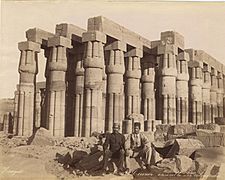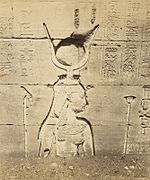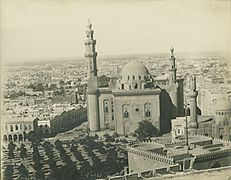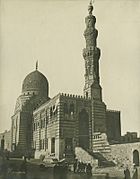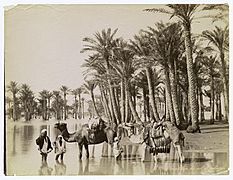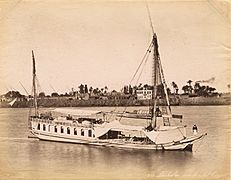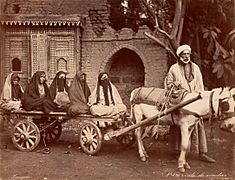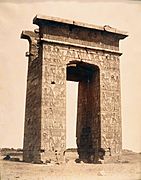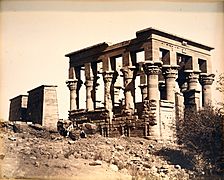Adelphoi Zangaki facts for kids
Quick facts for kids
Adelphoi Zangaki (Zangaki Brothers)
|
|
|---|---|
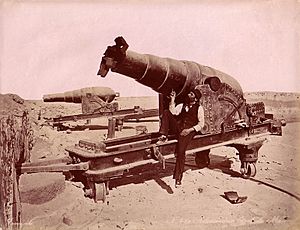
One of the Zangaki brothers, sitting on a cannon and pointing to the initials G.Z. carved on its barrel, most likely George, 1870s
|
|
| Born |
(Probably) George and Constantinos Zangakis
Dates unknown |
| Died | Unknown |
| Nationality | Greek |
| Known for | Photographers |
| Movement | Orientalist |
The Adelphoi Zangaki (which means Zangaki Brothers) were two brothers, probably named C. and G. Zangaki. They were from Greece and worked as photographers in Egypt from the 1860s to the 1890s. They were famous for taking pictures of old buildings and everyday life scenes. Their photos were very popular with tourists. They sometimes worked with a French photographer named Hippolyte Arnoux in Port Said. Together, they took pictures of the Suez Canal as it was being built. They were also among the first photographers to create large pictures of Egypt in the late 1800s.
Contents
Who Were the Zangaki Brothers?
We don't know much about the Zangaki brothers, except their first initials, C. and G. They had photography studios in Port Said and Cairo. They worked there from about the 1860s until at least the 1890s. Many of their photos are signed with a brother's initial, like "C. Zangaki," or with their studio location, like "Zangaki, Cairo."
For a long time, people thought "A. Zangaki" was just one photographer. But then, a sign was found that said "Adelphoi Zangaki," which means "Zangaki Brothers." This showed that they were indeed brothers. Experts believe their names were George and Constantinos (or Costas). Some think they were born on the Greek island of Milos, while others suggest they were from Cyprus. However, we don't have clear proof of where or when they were born. We also don't know how they learned photography. But soon after they arrived in Egypt, they became well-known photographers.
Early Photographers in Egypt
By the 1850s, many tourists were visiting Egypt. They wanted to buy photographs as souvenirs of their trips. Because of this, a small group of early photographers came to Cairo and the Nile valley. Most of these photographers were from France. Some of these pioneering photographers included Félix Bonfils, Gustave Le Gray, Emile Béchard, the British-Italian brothers Antonio Beato and Felice Beato, and Hippolyte Arnoux. Later, Gabriel Lekegian also joined them.
What Did They Photograph?
The Zangaki brothers' photos can be found in old tourist albums from the Middle East. Their studio in Port Said was a perfect spot to sell pictures to Europeans on their "Grand Tour" of famous places. The Zangaki brothers traveled along the Nile River. They had a special horse-drawn wagon that served as a darkroom! This allowed them to take pictures of Egypt's beautiful scenery, ancient buildings, and daily life.
Their photos show famous places like the pyramids at Giza and the Sphinx. They also captured cities like Suez and Alexandria. They photographed Egyptians doing everyday things, such as a teacher with students, men working by the Nile, or women at home.
They might have worked with the French photographer Hippolyte Arnoux to document the building of the Suez Canal. Many experts believe Arnoux was the official photographer for the canal. The Zangaki Brothers may have helped him. However, we don't know exactly how they worked together. In 1874, Arnoux had a disagreement with the Zangaki Brothers. He said they were using his ideas and photos without permission. Arnoux won the case in 1876.
They also took pictures in Palestine. They photographed areas in Jerusalem, Bethlehem, Mar Saba, Mount Tabor, and the Jerusalem railway. Some of their original glass negatives and prints are kept in the collection of the Palestine Exploration Fund.
Why Are Their Photos Important?
Art historian John Hannavy said that the Zangaki brothers "produced some of the finest images" of Egypt in the late 1800s. Their photos were mainly made for the many European tourists visiting Egypt. Today, historians and collectors value their pictures highly. They give us a wonderful look at what life was like in Egypt during that time.
- Photographs by Zangaki Brothers
-
Colonnade at Luxor
-
Inundated scene on the Nile
-
Karnak, Gate of Ptolemy III
See also
- History of Photography
- List of Orientalist artists
- Orientalism



